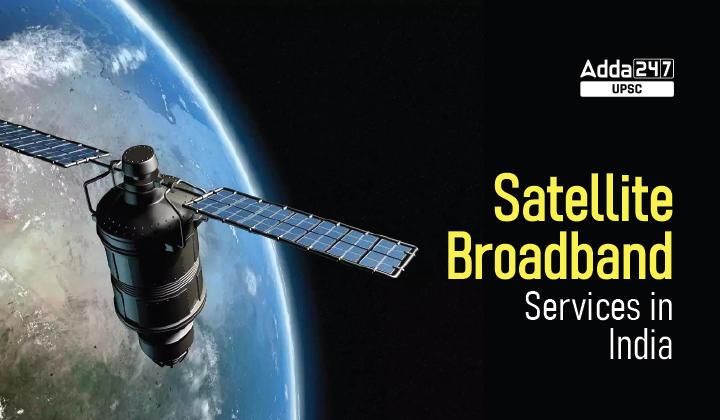Table of Contents
Satellite Broadband Services in India: Relevance for UPSC Exam
General Studies III- Awareness in The Fields Of It, Space, Computers, Robotics, Nano-Technology, Bio-Technology, Pharma Sector & Health Science
Satellite Broadband Services in India: Context
The race for providing satellite broadband connectivity in India is heating up as companies like Jio, Oneweb, Hughes and Tata-backed Nelco are preparing to provide these services.
- Earlier last month, Hughes Communications India (HCI), a satellite internet service provider launched India’s first high throughput satellite (HTS) broadband service powered by ISRO satellites.
- It used Ku-band capacity from ISRO GSAT-11 and GSAT-29 satellites with Hughes JUPITER Platform ground technology to deliver high-speed broadband.
What is a Satellite Broadband Service?
- Broadband essentially means a wide bandwidth, high-capacity data transmission technique, using a broad range of frequencies.
- In the case of a satellite broadband service, broadband services are delivered directly via satellites instead of optical fibre or mobile networks.
How is it different from existing broadband services?
- The main difference is that aggregation of all the data generated and transmitted by users accessing the internet happens in the sky or space that is in the satellite.
- In contrast to this, if we take a look at cellular networks, aggregation happens on the ground, in the base stations through optical fibre, cable, etc.
- Another key difference is that to access satellite services, we will need a dish antenna just like we do in the case of TV services, so a normal mobile handset cannot directly access satellite broadband.
- For a user to access satellite broadband a clear line of sight to the satellite is needed.
Satellite Broadband Services in India: Advantages
- The main advantage of satellite services is that you can provide high-speed internet services in remote areas, where terrestrial networks cannot be set u.
- In a country with a wide range of geographies such as India, 20-25 per cent of the Indian population resides in areas where it is extremely hard for terrestrial operators to install internet facilities.
Satellite Broadband Services in India: Scope in India
- Currently, VSAT operators offer satellite broadband services at a very limited capacity in India in a few remote locations.
- The utilisation of satellite services for broadband services is restricted to minimal applications — such as disaster management, defence, scientific locations, etc.
How India (undoubtedly, the ISRO) has geared up for adapting to this?
- ISRO’s high throughput GEO (Geostationary Equatorial Orbit) satellites – GSAT-11 and GSAT-29 a few years ago, can beam high-speed internet up to 300 gigabytes per second.
- Apart, many global players look to provide satellite broadband services in India by deploying low earth orbit (LEO) satellites.
- They are launching a constellation of satellites very close to the earth’s surface in order to reduce the latency of satellite broadband.
- Presently, Elon Musk’s Starlink, Sunil Bharti Mittal-backed OneWeb and the Canadian satellite major Telesat are eyeing the Indian market.
When will these services be available in India?
- If things go as planned and the players get the necessary regulatory clearance, these services could become operational in India as soon as next year.
- OneWeb wants to provide backhaul services to telcos by mid-next year, while Starlink wants to provide direct broadband services by December 2022, aiming at 2 lakh terminals.
- Telesat, on the other hand, is eyeing n India launch by 2024.
Satellite Broadband Services in India: Cost?
- The provision of direct broadband services through satellites will be pricey.
- According to a user guide for India, provided by Starlink, the first-year cost of a Starlink terminal will be ₹1,58,000 after which it will cost around ₹1,15,000 every year.
Satellite Broadband Services in India: Major hurdles
- Latency: Additionally, satellite Internet latency can be a significant problem. This can be a matter of only a second or two, but a delay on that scale can seriously affect real-time applications like video chats.
- Spatial hurdles: Users might not be able to connect to a satellite at all if they are located under heavy foliage or surrounded by other obstructions.
- Limited bandwidth: Satellite data transfer provides very slow Internet speeds and limited satellite bandwidth because of the distances the signals have to travel and all the potential obstacles in between.
- Connection times: This can also be impacted by your surroundings, the length of your message, and the status and availability of the satellite network.
- High input cost: This along with the complex equipment like satellite dishes being used to avail these services makes the service expensive.
Way forward
- An urgent re-look at deregulation and privatization is required.
- Advanced space-faring nations have privatized most of these blocks in the value chain.
- There is a need for building systems to help nurture the industry and create an extensive ecosystem to generate a ‘Space 2.0’ in India.




 TSPSC Group 1 Question Paper 2024, Downl...
TSPSC Group 1 Question Paper 2024, Downl...
 TSPSC Group 1 Answer key 2024 Out, Downl...
TSPSC Group 1 Answer key 2024 Out, Downl...
 UPSC Prelims 2024 Question Paper, Downlo...
UPSC Prelims 2024 Question Paper, Downlo...
